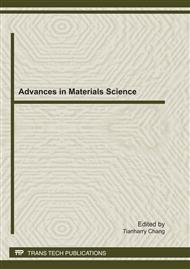p.57
p.61
p.66
p.72
p.76
p.81
p.85
p.89
p.94
Ti50Fe25Ni25 Amorphous Alloy Prepared by Mechanical Alloying
Abstract:
A new ternary Ti-based amorphous alloy, Ti50Fe25Ni25, is prepared by the mechanical alloying. The milling is performed in a high-energy planetary ball mill under argon atmosphere. Fully Ti50Fe25Ni25 amorphous alloy powder is obtained after milled 160h. The milling speed is 300rpm and the weighs ratio of ball to powder is 10:1. The structural features are studied by X-ray diffraction and field emission scanning electron microscope, and the thermal stability is investigated by a differential scanning calorimeter. The super-cooled liquid region of the amorphous alloy increases from 98K to 119K as the heating rate increasing from 10K/min to 40K/min. The effective activation energy of crystallization is estimated with modified Kissinger’s plot. The initial crystallization activation energy Ex1 and the first crystallization peak Ep1 are 155.9KJ/mol and 188.5KJ/mol, respectively.
Info:
Periodical:
Pages:
76-80
Citation:
Online since:
September 2011
Authors:
Keywords:
Price:
Сopyright:
© 2011 Trans Tech Publications Ltd. All Rights Reserved
Share:
Citation:


